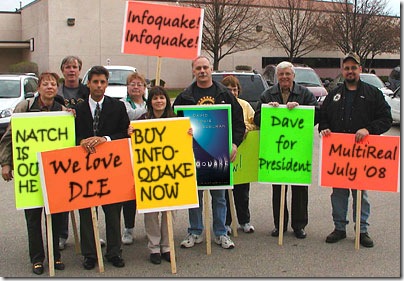I can’t find any current piece of journalism to use as a springboard for asking whether the novel will die. But considering that the question gets asked every 14 seconds somewhere on the blogosphere, I’m not going to worry. Just follow the trail of rent garments and gnashed teeth and you’ll find someone blathering about it. The question’s on my mind this morning, so that’s good enough for me.
Will the novel die? I won’t keep you in suspense: Yes, the novel will die. It might not happen in your lifetime. But yes, I can say unequivocally that the novel will eventually breathe its last and lay down contentedly in the grave of dead art forms. I’ll be very conservative and estimate 50 years.
And you know what? It’s not that big a deal.
Ever since the advent of television, people have predicted the demise of the novel, and other people have smugly sat back and declared that since it hasn’t happened yet, it won’t happen at all. But I think a lot of these defenders of the novel have a fundamental misunderstanding of what a novel is, not to mention a fundamental misconception of its importance.
First off, we have to consider the question of what it means to be a dead medium. A dead medium is simply one which does not produce a significant number of new works of art. When a medium of expression dies, that doesn’t mean that the jackbooted Art Police storm into your house in the middle of the night to burn every instance of it they can find. Life ain’t Fahrenheit 451. If the last novel rolls off the printing press tomorrow at 9 a.m., we’ll still have hundreds of millions of novels lying around to enjoy until they crumble into dust. And unlike, say, the 8-track tape or the HD-DVD, there’s no specialized equipment necessary for reading novels.
Nor do the Art Police threaten anyone with imprisonment who dares to create art in a dead medium. Vinyl is a dead medium for music, and yet there are still people producing vinyl records. Polka is a dead art form, and yet you can still find people not named Weird Al Yankovic creating polka. Given the importance of the novel to Western civilization, I’m sure that printers will continue pumping the things out in special limited editions long after the masses have stopped buying them in mass quantities.
You might think that I’m mixing up the terms medium and form here. The medium of the novel is that 8″ x 12″ hunk of pulped wood, while the form of the novel is the 120,000 words of prose that gets inked onto the surface. But the point I’m trying to make here (as Frank Lloyd Wright and Marshall McLuhan made long before me) is that those two things are inextricably tied together. The medium of the novel is its form.
We haven’t always had novels. No, in fact, while recorded human history has been going on for five thousand years now (depending on how you define it), the novel has been around for less than five hundred (depending on how you define it). Socrates, Plato, and Aristotle never read a single novel in their lives; I don’t think Shakespeare could have read more than a handful of them.
The fact of the matter is that the novel itself is an art form that evolved to take advantage of a certain new technology, namely the printing press. Why do books tend to be no larger than around 8″ x 12″? Because that’s about as large as you can make a book and still be able to hold it comfortably in your hands and transport it from place to place. Why does the print tend to be around a point size of 12? Because that’s about as small as you can make text and still have it be readable at arm’s length. Take those limitations and you’ll find that you can’t easily pack more than 200,000 words into a single novel.
So the novel is, in fact, a device that’s both created by and limited by certain factors of human physiology. These same limitations govern any art form. Ever wonder why most films are less than 180 minutes in length? There are certain issues surrounding the economics of movie theater chains and the technical specs of film projectors, but the real reason is even simpler. 180 minutes is about the amount of time that human beings can comfortably sit and pay attention to a film without having to either eat or hit the bathroom. Tack in an intermission or two and you can extend that timeframe for a while. But until we’ve got gastrointestinal and neurological programming that allows us to drastically extend the amount of time between bathroom breaks and naps, you’re never going to see, say, a 26-hour movie.
